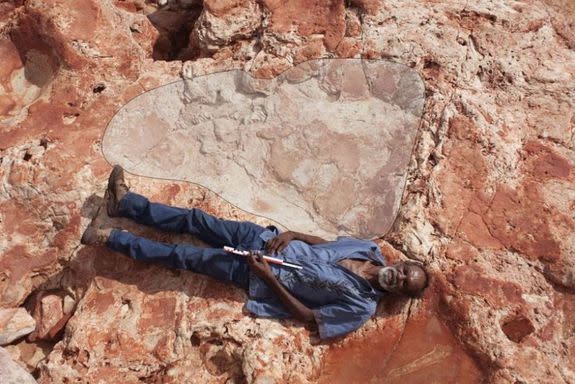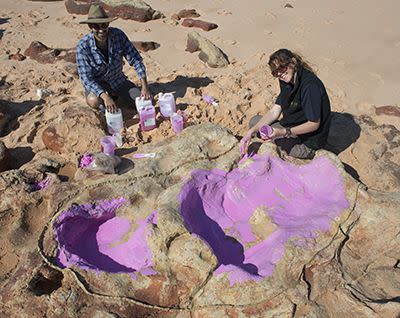The world's largest dinosaur tracks have been found, and a human can fit in them

Scientists have discovered some of the world's largest dinosaur tracks—measuring as long as the average person is tall—in western Australia.
The 5.5-foot-long tracks likely belonged to a long-necked, small-headed sauropod. They're part of an unusually diverse array of dinosaur tracks imprinted into the rocks on Australia's Dampier Peninsula.
SEE ALSO: Earliest dinosaurs may have originally come from Britain, new study says
Paleontologists from the University of Queensland and James Cook University recently identified 21 different types of tracks on the 16-mile stretch of coastline. Rocks in the Kimberley region date back to 127 million to 140 million years ago, the team said in a new study published in the Journal of Vertebrate Paleontology.

Image: steve salisbury
"It's such a magical place—Australia's own Jurassic Park," Steve Salisbury, the study's lead author a vertebrate paleontologist at the University of Queensland, said in a news release.
Salisbury and his team spent more than 400 hours investigating and documenting the "unprecedented" panoply of dinosaur tracks.
They found five different types of predatory dinosaur tracks and at least six types of tracks from herbivorous sauropods, including the human-sized footprints.
"Most people would be able to fit inside tracks that big, and they indicate animals that are probably around 5.3 to 5.5 meters [17.4 to 18 feet] at the hip, which is enormous, Salisbury told the Australian Broadcasting Corp.

Image: steve salisbury
In terms of size, the sauropod tracks top a dinosaur footprint found in the Mongolian desert that measured about 3.8 feet long.
Salinger's team also identified four types of tracks from two-legged, plant-eating ornithopods and six types of tracks from dinosaurs bedecked with spikes and plates, such as the stegosaurus.
Their work was prompted by the potential development of a $40 billion liquified natural gas processing plant in Walmadany. Concerned the plant would pave over the area's stunning environment, the Goolarabooloo people, the local traditional custodians, contacted Salisbury and his team.
"We needed the world to see what was at stake," Phillip Roe, the Goolarabooloo law boss, said in the news release.
Fortunately for residents and paleontologists alike, the west Kimberley region was listed as a National Heritage Place in 2011, and two years later, the natural gas project collapsed.
